Former AFL coach Rodney Eade fears footy is going backwards, calls for starting positions to be introduced
The man who introduced flooding to the AFL has a warning for the league. It’s time to act now or ‘dour’ footy games like the ones on the weekend will become the normal. But why are we in this position?
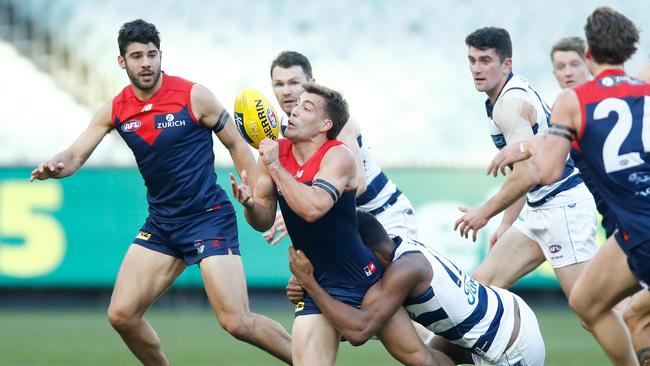
Mark Robinson
Don't miss out on the headlines from Mark Robinson. Followed categories will be added to My News.
The coach who introduced flooding to the AFL, Rodney Eade, is agitating for starting positions to be introduced to help save the game as a spectacle.
Previously dismissed by the AFL, Eade argues starting positions at all stoppages, boundary throw-ins and kick-ins after a behind would help solve congestion and help teams transition the ball.
The ability of teams to move the ball from their defensive 50m to their offensive 50m is at lowest.
Eade, who coached Sydney, the Western Bulldogs and Gold Coast, is emphatic that starting positions need to be considered.
He argues three sets of pairs, maybe four, should be inside the 50m arcs, and players would have six seconds to get back inside the arc.
Kayo is your ticket to the 2020 Toyota AFL Premiership Season. Watch every match of every round Live & On-Demand. New to Kayo? Get your 14-day free trial & start streaming instantly >
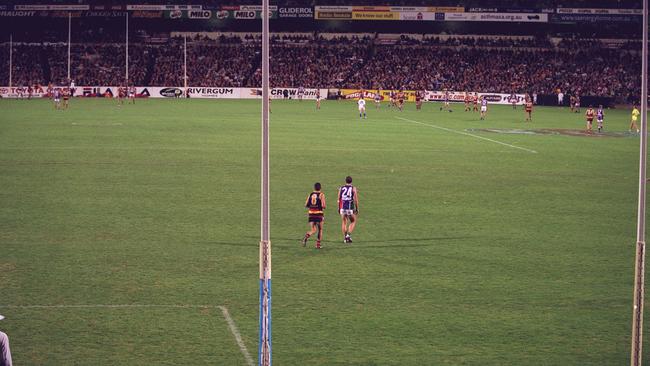
“I don’t think it’s radical, I think it’s getting to the stage where it’s necessary,’’ Eade said.
“I’m not the expert on this, but there’s too much noise about the game now and it’s becoming quite a strong noise.
“It’s certainly not radical and it can be effective.
“It’s what we used to play anyway and you’re more likely to have open space and less players around the ball.’’
An AFL spokesman told the Herald Sun earlier this month that starting position at all stoppages “hasn’t been discussed or considered”.
Eade disagreed: “It needs to be considered,’’ he said.
The AFL introduced 6-6-6 for centre-bounce ball-ups for the 2019 season in a bid to ease congestion and increase scoring.
The scoring was the lowest since 1966.
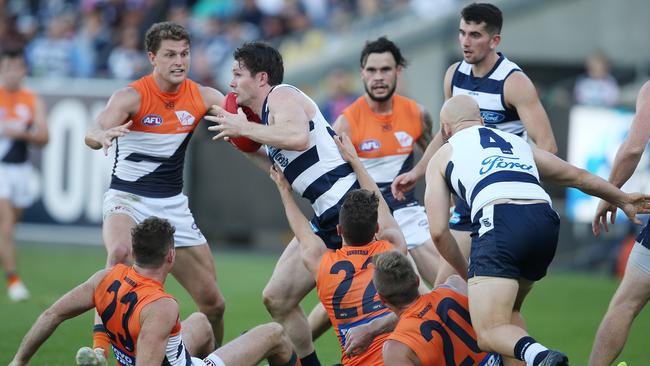
Eade is in favour of reducing interchange rotations from the current 90- down to 60 or 70 to fatigue players, as well bring in starting positions.
He watched parts of both Sunday games — Geelong v Melbourne and North Melbourne v Hawthorn — and was dismayed at the spectacle.
“They were hard to watch,’’ he said.
“If you bring down interchange to 60 or 70, you’re not going to get the forwards running the full length of the ground to defend because they’ve got to get back inside their forward 50m arc,’’ he said.
“Now, it’s an 18-man team defence across half the ground and it’s difficult to get through.
“People won’t notice starting positions much. At stoppage now, people run out of the stoppage and back to their set up.’’
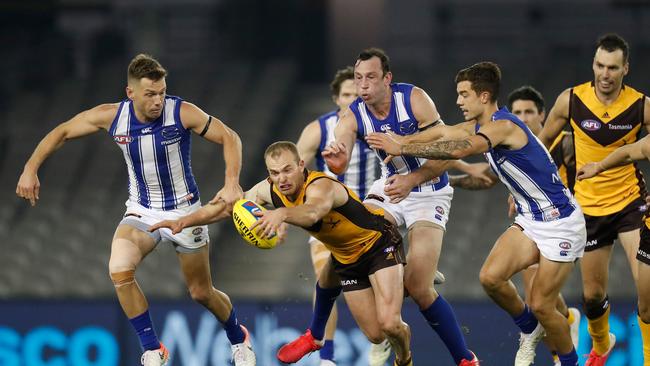
He said a free kick paid for not having the set number of players in the arc would encourage players to stay in or close to their positions.
“What you will find is players will stay at home,’’ he said.
“I don’t think it’s radical, no, but people do say that because they say we’re going to bibs. But. you don’t have to paint any more lines on the ground, you will have free kicks early on and people will up in arms, just like when the deliberate point was introduced, but after a while and this is the main thing, coaches don’t like free kicks paid against them. They hate it.
“Players adapt. we could have any rule you like and players will adapt to it. And coaches will adapt and you will see more positional play.’’
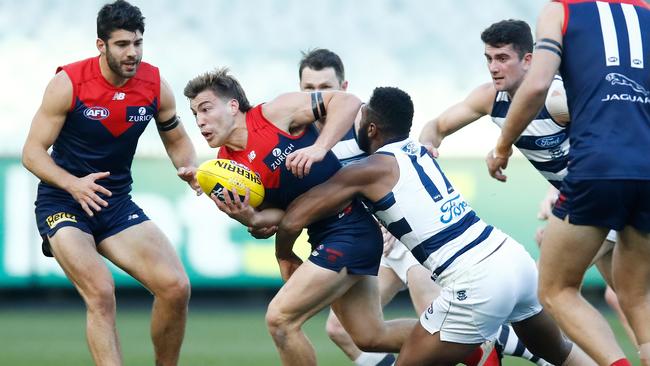
“It will never go back to what it was, but at least you’ll have players in traditional positions.’’
He said a ball up on the wing would require at least six players in each arc and players between the stoppage and the forwards as a ‘’conduit’’.
“It’s all about dragging players away from the ball.’’
AFL boss Gillon McLachlan said on Monday he would like a clamp down on free kicks paid for holding the ball, a response to Hawks coach Alastair Clarkson complaining about a lack of free kicks paid in his match on Sunday.
Last year, AFL head of football Steve Hocking said he did not want excessive tackling being a “feature of the game”.
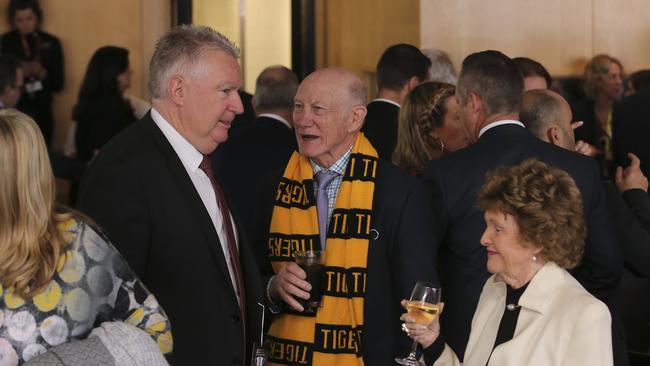
ROBBO: IS THE GAME IN TROUBLE
It’s a simple question: Is the game in trouble?
Former coach Rodney Eade argues yes.
“People say the game will work itself out and evolve, but it’s evolving the other way,’’ he said.
“It’s becoming a more dour game, a more defensive game, more a battle of attrition and no flow.’’
He’s worried for the youth who will not be entertained with goals, high-marking and players running with the ball, facets of the game quickly disappearing.
“Rusted on supporters, pick an age, say 45, all talk about the game and still like the game, it’s the 15-year-olds or 20-year-olds, two generations away, you worry about them becoming rusted on supporters,” Eade said.
“We are in the entertainment industry and I know Eddie McGuire got howled down and he was talking about the length of the game, but this is about the entertainment value of the game. We have to look at the bigger picture.’’
Eade sees what all see: short kicking, retaining possession, ball being moved from wing to wing and, when it happens, tackling in numbers.
“We need to encourage flow footy,’’ he said.
It didn’t happen in the two Sunday matches — North Melbourne v Hawthorn and Geelong v Melbourne.
The Hawks-Kangas game was ultra boring for two quarters, as both teams struggled to move the ball from their defensive 50m arc to their forward 50m arc.
North Melbourne generated an inside 50 from just 5.3 per cent of its defensive 50 chains — just two from 38 chains.
Hawthorn generated an inside 50 from just 8.3 per cent of its defensive 50 chains — just two from 24 chains.
The league average this year is 17 per cent.
In 2016, the league average was 21.
It’s a staggeringly low number and highlights the game’s pain.
Eade says coaches are ‘’mainly to blame’’.
“Coaches control the movement and what the game is,’’ he said. ‘’Their only mindset is to win games and that’s fair enough.’’
He said some coaches want to slow the game to protect the team from being scored on turnover, which is the main source of scoring.
He says that’s been a massive change in the game.
“There’s two ways to make the game slower, one is congestion, so we get numbers around the ball and cause stoppages, and the other is with the ball in hand,’’ he said.
“Matthew Scarlett encapsulated it. He said last year, teams are now defending with the ball in hand and in the past, you always defended without the ball.
“Teams are slow and precise with the ball, they chip it around, therefore players place themselves on the ground and behind the ball — they call it structure — so if there is a turnover they can defend it and don’t get scored against.
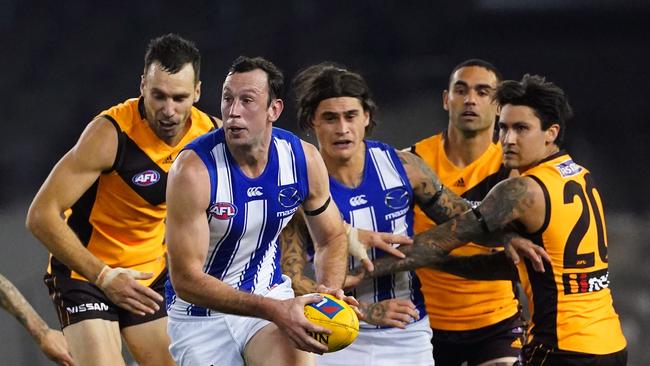
“Hawthorn is the example. Round 2 at Geelong, they took the game on and made mistakes and got blown away, and now they’re back to controlling the game to avoid turnover
“Take Geelong. In Round 1 against GWS, Geelong tried to score and took the game on. Round 2 v Hawthorn took the game on and Geelong won easily. Geelong lost to Carlton on the back of mental attitude and then they couldn’t afford to lose against Melbourne. They’ve changed their mode from Round 1.’’
The players, he indicated, had become robots on a production line.
Eade agreed with former player Nick Dal Santo who said on Fox Footy’s First Crack on Sunday night the players had lost their instinct.
MORE AFL NEWS:
How AFL is working to ensure 2020 season can make it through COVID-19 crisis
Carlton’s Jack Silvagni says Zach Merrett was ‘unlucky’ to be suspended for striking
“With game plans, structures and systems, they are the words we use today, we’ve coached the instinct out of players. It’s about no mistakes, control the ball, get a stoppage, kick to the point post, get numbers around, set up behind the ball and don’t let them out and let’s not be scored against,’’ he said.
“Some people might be happy with the way football is going. I’m not saying the game’s completely broken but a lot of people are.
“Who’s the main stakeholder? The fans.
“It’s not the players or coaches, it’s the fans. So we have to work out if the fans are happy with the game, and we’re all fans.”
WHAT THEY SAID
“I have said for many years the game as a spectacle and full of highlights is in serious trouble.
“Use the Cats as a typical example on the weekend with some of the game’s greatest ever players, they kicked 1 goal 2 behinds in half a game and that took 150 disposals.
“That is not football, that’s keepings off.
“In 1989 grand final for example, Geelong and Hawthorn kicked a goal every 11 possessions because scoring was a priority.
“Now you tell me which style of game entertains and thrills.”
— Richmond legend Kevin Bartlett on Twitter.
“They (Melbourne v Geelong and Hawthorn v North Melbourne) were awful games.
“I think the starting point is instead of 15 metre kicks, it should be moved to 20 or 25 metre kicks
That would stop the possession style game.
The other aspect is umpires, and I think they need to ball the ball up quicker (instead of waiting for ruck nomination).
“And also backward kicks should be play on.” — Essendon champion Matthew Lloyd on the AFL website.
“I haven’t spoken to Clarko. I don’t agree with Clarko on the state of the game.
“There were some cracking games on the weekend and there were some average games, that’s football, that’s sport.
“I do agree with him to an extent on holding the ball. I disagree with one thing; you need prior opportunity.
“You can’t have guys taking the ball and not having prior opportunity,” — AFL boss Gillon McLachlan on Monday.
“Trial this next season in the (pre-season competition). Four players inside 50 at all times.
“Either end of the ground at all times of the game, you must have four inside your forward 50 – two of each.
“You want to break congestion up, then limit the players that can vacate their forward line and cause more congestion.
“Four have got to stay back compulsorily.
“We’ll get some more contests, we might get some more high marking from your forwards and we might get some more bags of goals,” — Melbourne great Garry Lyon on SEN.
— Compiled by Nick Smart
